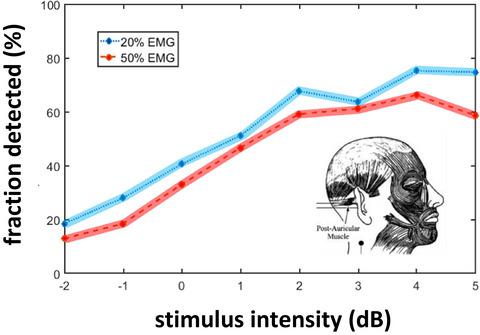当前位置:
X-MOL 学术
›
Eur. J. Neurosci.
›
论文详情
Our official English website, www.x-mol.net, welcomes your
feedback! (Note: you will need to create a separate account there.)
Muscles in and around the ear as the source of “physiological noise” during auditory selective attention: A review and novel synthesis
European Journal of Neuroscience ( IF 2.7 ) Pub Date : 2021-01-23 , DOI: 10.1111/ejn.15122 Andrew Bell 1 , W Wiktor Jedrzejczak 2
European Journal of Neuroscience ( IF 2.7 ) Pub Date : 2021-01-23 , DOI: 10.1111/ejn.15122 Andrew Bell 1 , W Wiktor Jedrzejczak 2
Affiliation

|
The sensitivity of the auditory system is regulated via two major efferent pathways: the medial olivocochlear system that connects to the outer hair cells, and by the middle ear muscles—the tensor tympani and stapedius. The role of the former system in suppressing otoacoustic emissions has been extensively studied, but that of the complementary network has not. In studies of selective attention, decreases in otoacoustic emissions from contralateral stimulation have been ascribed to the medial olivocochlear system, but the acknowledged problem is that the results can be confounded by parallel muscle activity. Here, the potential role of the muscle system is examined through a wide but not exhaustive review of the selective attention literature, and the unifying hypothesis is made that the prominent “physiological noise” detected in such experiments, which is reduced during attention, is the sound produced by the muscles in proximity to the ear—including the middle ear muscles. All muscles produce low‐frequency sound during contraction, but the implications for selective attention experiments—in which muscles near the ear are likely to be active—have not been adequately considered. This review and synthesis suggests that selective attention may reduce physiological noise in the ear canal by reducing the activity of muscles close to the ear. Indeed, such an experiment has already been done, but the significance of its findings have not been widely appreciated. Further sets of experiments are needed in this area.
中文翻译:

耳内和耳旁肌肉是听觉选择性注意过程中“生理噪声”的来源:综述和新颖的综合
听觉系统的敏感性通过两个主要的传出途径进行调节:连接至外部毛细胞的内侧少毛囊系统以及中耳肌肉-张量鼓室和骨。前者在抑制耳声发射方面的作用已得到广泛研究,但互补网络却没有。在选择性注意的研究中,对侧刺激刺激了对侧刺激引起耳声发射的减少,但是公认的问题是结果可能与平行肌肉活动相混淆。在这里,通过对选择性注意文献的广泛但非详尽的考察来研究肌肉系统的潜在作用,并作出统一的假设,即在此类实验中检测到突出的“生理噪声”,在注意力过程中降低的是耳朵附近的肌肉(包括中耳肌肉)产生的声音。所有的肌肉在收缩过程中都会发出低频声音,但是对于选择性注意实验(耳朵附近的肌肉很可能活跃)的意义尚未得到充分考虑。这项综述和综合表明,选择性注意可以通过减少靠近耳朵的肌肉的活动来减少耳道的生理噪声。确实,已经进行了这样的实验,但是其发现的重要性尚未得到广泛认可。在这一领域还需要进一步的实验。所有的肌肉在收缩过程中都会发出低频声音,但是对于选择性注意实验(耳朵附近的肌肉很可能活跃)的意义尚未得到充分考虑。这项综述和综合表明,选择性注意可以通过减少靠近耳朵的肌肉的活动来减少耳道的生理噪声。确实,已经进行了这样的实验,但是其发现的重要性尚未得到广泛认可。在这一领域还需要进一步的实验。所有的肌肉在收缩过程中都会发出低频声音,但是对于选择性注意实验(耳朵附近的肌肉很可能活跃)的意义尚未得到充分考虑。这项综述和综合表明,选择性注意可以通过减少靠近耳朵的肌肉的活动来减少耳道的生理噪声。确实,已经进行了这样的实验,但是其发现的重要性尚未得到广泛认可。在这一领域还需要进一步的实验。确实,已经进行了这样的实验,但是其发现的重要性尚未得到广泛认可。在这一领域还需要进一步的实验。确实,已经进行了这样的实验,但是其发现的重要性尚未得到广泛认可。在这一领域还需要进一步的实验。
更新日期:2021-01-23
中文翻译:

耳内和耳旁肌肉是听觉选择性注意过程中“生理噪声”的来源:综述和新颖的综合
听觉系统的敏感性通过两个主要的传出途径进行调节:连接至外部毛细胞的内侧少毛囊系统以及中耳肌肉-张量鼓室和骨。前者在抑制耳声发射方面的作用已得到广泛研究,但互补网络却没有。在选择性注意的研究中,对侧刺激刺激了对侧刺激引起耳声发射的减少,但是公认的问题是结果可能与平行肌肉活动相混淆。在这里,通过对选择性注意文献的广泛但非详尽的考察来研究肌肉系统的潜在作用,并作出统一的假设,即在此类实验中检测到突出的“生理噪声”,在注意力过程中降低的是耳朵附近的肌肉(包括中耳肌肉)产生的声音。所有的肌肉在收缩过程中都会发出低频声音,但是对于选择性注意实验(耳朵附近的肌肉很可能活跃)的意义尚未得到充分考虑。这项综述和综合表明,选择性注意可以通过减少靠近耳朵的肌肉的活动来减少耳道的生理噪声。确实,已经进行了这样的实验,但是其发现的重要性尚未得到广泛认可。在这一领域还需要进一步的实验。所有的肌肉在收缩过程中都会发出低频声音,但是对于选择性注意实验(耳朵附近的肌肉很可能活跃)的意义尚未得到充分考虑。这项综述和综合表明,选择性注意可以通过减少靠近耳朵的肌肉的活动来减少耳道的生理噪声。确实,已经进行了这样的实验,但是其发现的重要性尚未得到广泛认可。在这一领域还需要进一步的实验。所有的肌肉在收缩过程中都会发出低频声音,但是对于选择性注意实验(耳朵附近的肌肉很可能活跃)的意义尚未得到充分考虑。这项综述和综合表明,选择性注意可以通过减少靠近耳朵的肌肉的活动来减少耳道的生理噪声。确实,已经进行了这样的实验,但是其发现的重要性尚未得到广泛认可。在这一领域还需要进一步的实验。确实,已经进行了这样的实验,但是其发现的重要性尚未得到广泛认可。在这一领域还需要进一步的实验。确实,已经进行了这样的实验,但是其发现的重要性尚未得到广泛认可。在这一领域还需要进一步的实验。











































 京公网安备 11010802027423号
京公网安备 11010802027423号